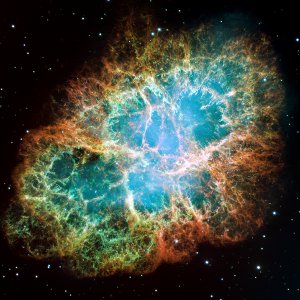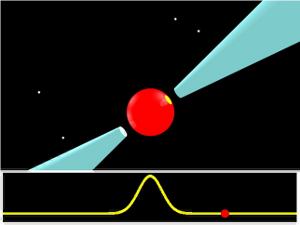Lovell Telescope setlist

The Crab Nebula. This is the remnant of a star that exploded in 1054. It was spotted by Chinese astronomers and others as a new star visible even in the daytime sky before it faded from view. Imaged here by the Hubble Space Telescope, this 11-light-year-wide glowing gas cloud is all that is left of the star. At its heart is the Crab pulsar (B0531+21) spinning 30 times a second, one of the targets on the Lovell Telescope's setlist. (Credit: NASA/ESA/J. Hester & A. Loll, Arizona State University)

This is an artist's impression of a pulsar showing the twin beams of radio waves shooting from the magnetic poles of a neutron star. As the star spins the beams sweep across our line of sight and the pulsar flashes like a cosmic lighthouse. (Credit: Michael Kramer).
The Lovell Telescope will be observing pulsars during Transmission 001 of Live from Jodrell Bank on 2011 July 2nd.
Pulsars are spinning neutron stars - the collapsed cores of exploded stars called supernovae. Only about the size of a city, they weigh as much as the Sun. They shoot beams of radio waves from their magnetic poles, so as they spin we see them flash like cosmic lighthouses. We use the Lovell Telescope to accurately time the arrival of these flashes of radio waves. This helps us test our understanding of extreme physics.
You can listen to our recordings of the sound of pulsars including the Crab Pulsar and find out more about pulsars.
Whilst the bands play during the afternoon and early evening of July 2nd the Lovell Telescope will be observing the following pulsars (further details of the pulsars are also available).
J0737-3039A
B0531+21
B0450+55
B0609+37
B0655+64
J0943+2253
J0947+2740
J1022+1001
B1133+16
J1238+21
J1246+2253
B1237+25
J1518+4904
B1508+55
B1530+27
B1257+12
J1549+2110


